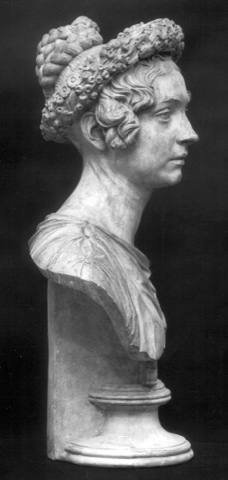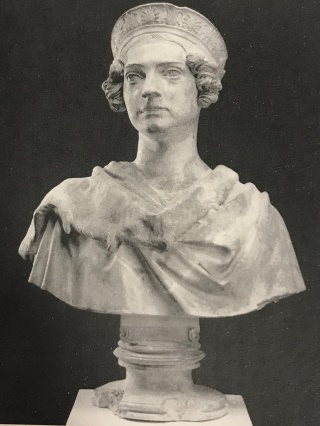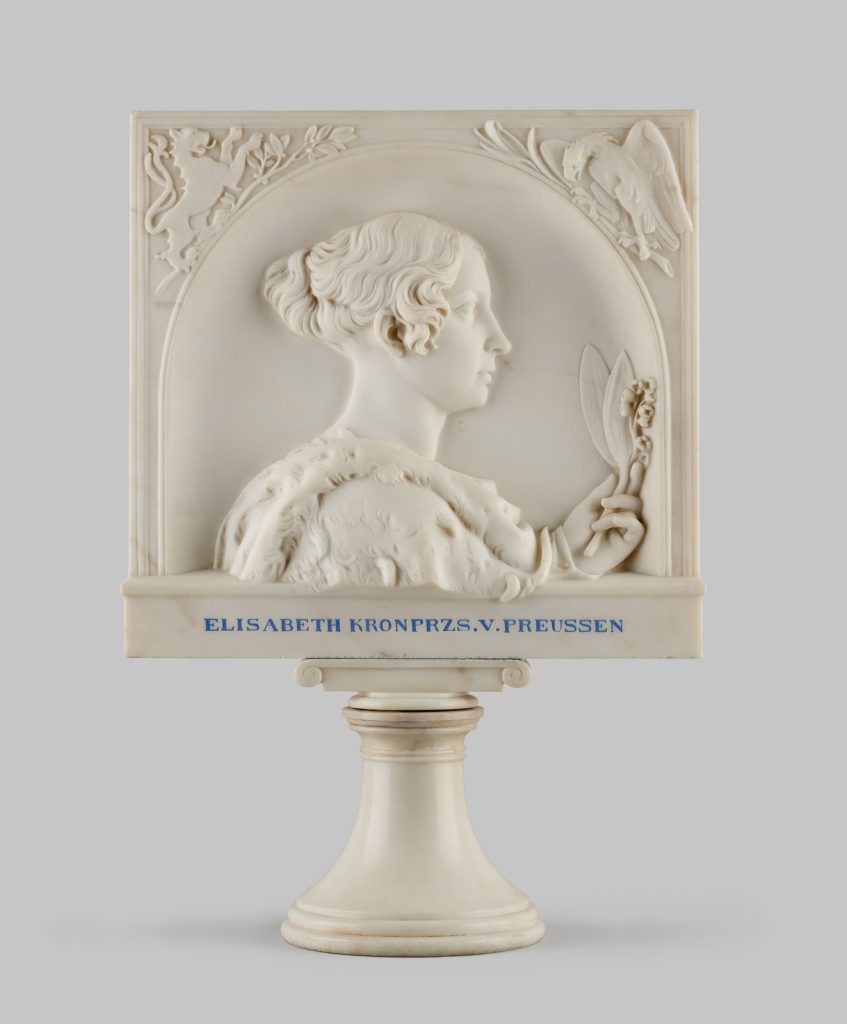Christian Daniel Rauch
(Arolsen 1777 - 1857 Dresden)
A Portrait Relief of Elisabeth, Crown Princess of Prussia, 1834-7
Carrara marble, 34.2 x 35.7 cm without base, height 52.4 cm with base.
Incised inscription inlaid with blue mineral paste ELISABETH KRONPRZS. V. PREUSSEN
Provenance:
Private collection, Germany
The existence of the present Carrara marble portrait relief was unknown to scholars until its recent discovery in a private collection. The relief shows Elisabeth, Crown Princess of Prussia, in profile to the right. A panel beneath the portrait bears the incised inscription ELISABETH KRONPRZS. V. PREUSSEN inlaid with blue mineral paste. The relief was produced by the sculptor Christian Daniel Rauch (1777-1857) and his Berlin workshop between September 1834 and January 1837. The relief is mounted on a swivel base.
Elisabeth is shown in profile with her hair drawn up in a chignon at the back of her head and coiffed in soft side ringlets. She wears an ermine stole around her neck and shoulders. In her raised left hand she holds a sprig of lily of the valley, reputedly her favorite flower. The portrait is set in a semi-circular niche within a square panel. Heraldic motifs fill the spandrels above the niche – a Bavarian lion at the left and a Prussian eagle at the right. Beneath the niche an inscription panel acts as a parapet-like frame.
Princess Elisabeth Ludovika of Bavaria (November 13, 1801-December 14, 1873) married the heir apparent to the Prussian throne, Crown Prince Friedrich Wilhelm (October 15, 1795-January 2, 1861) on November 16, 1823. On the death of Friedrich Wilhelm III of Prussia (August 3, 1770-June 7, 1840) the Crown Prince succeeded him as Friedrich Wilhelm IV of Prussia.
A large number of original sources have survived. They include Rauch’s journals and ledgers, which give especially valuable insight into the organization of his studio workshop – from the creation of designs to information about procedures, studio collaborators and assistants, production costs and the dating of individual works.[1] Unfortunately the correlation between entries in the source material and sculptures that are known today is not always clear-cut and unambiguous. In some cases, confusion arises where the sources only offer an imprecise description of a piece. This can lead to a false correlation. To add to the confusion, a number of the sculptures listed in the sources are no longer extant. In addition, and notably in the case of the royal portraits, more than one version of a piece was sometimes produced. The same applies to Rauch’s various portraits of Crown Princess Elisabeth. That the source material should be so clearly and unambiguously correlatable with the present portrait relief – as these research findings show – is therefore all the more gratifying.
This relief is the earliest of three extant versions. According to the sources, work on this version began in September 1834 and it was not completed until January 1837. The second version is a stucco dating from 1836[2] now housed in the Nationalgalerie in Berlin (SMB NG, inv. RM 259). The third and last version was made after 1840. The inscription it bears – ELISABETH KOENIGIN. V. PREUSSEN – establishes a terminus post quem, namely that it can only have been made after June 1840 when the coronation of Friedrich Wilhelm IV took place. This third version is now in the collection of the Bayerisches Nationalmuseum in Munich (inv. 2013/149).
Rauch’s point of departure for the present marble relief profile may have been his Profil der Kronprinzessin for which the Crown Princess sat on September 24, 1834. An entry in his journal describes the profile as ‘small’ and ‘designed as the model for a carnelian intaglio’.[3] At about the same time, several of Rauch’s workshop assistants began preliminary work in Berlin on a version in marble. This is documented in one of Rauch’s ledgers where reference is made to a ‘model of a bust of the Crown Princess of Prussia in a niche’.[4]
According to the sources, work on the present relief began in September 1834 and continued until January 1837. Rauch was closely involved in the completion of the relief, working alongside his closest collaborators, assistants and students. Additional work was carried out by the sculptor Ceccardo Gilli (1798-1862) and by Carl Gramzow (1807-after 1863), Karl Heinrich Möller (dates unknown) and Albert Wolff (1815-92).[5] A ‘mechanicus’ named Gilow[6] (dates unknown) fitted a Drehscheibe or ‘turntable’ to the underside of the relief in December 1835 and another assistant took charge of the inscription.[7] Rauch was an active participant, noting meticulously in his journal: ‘November 10-14, 1835 – retouched the head of the Crown Princess in the marble niche’. A short time later (journal entry for December 2, 1835), he noted the completion of a ‘little model of a profile with a left hand, in a semi-circular niche […] (Her Highness the Crown Princess)’.[8]
The link between the present relief and the original sources, as cited above, appears conclusive. Rauch’s own references to a ‘left hand’ and a ‘semi-circular niche’ and the mention in the ledger of a ‘turntable’ set the present portrait apart from a portrait of the Crown Princess made in 1834 for Schloss Charlottenhof.[9] Details of this portrait and its present whereabouts are unknown.
In January 1836, Rauch filed an application with the Berlin Academy of Arts for copyright of a work titled Das Portrait I.K.H. der Frau Kronprinzessin, im Profil [portrait of Her Royal Highness the Crown Princess, in profile], handing over a stucco model (PrAdK 0084, January 9, 1836). In all likelihood the model in question was the stucco version[10] reproduced in Jutta von Simson’s catalogue raisonné and now housed in the Nationalgalerie in Berlin (SMB NG, inv. RM 259).[11]
The background to the commission for the present relief is impossible to piece together. Auguste Fürstin Liegnitz, the second wife of Friedrich Wilhelm III of Prussia, is said to have commissioned the work – publications by Friedrich Eggers[12] and Jutta von Simson[13] as well as a number of recent exhibition catalogues[14] take this view. The Fürstin is purported to have commissioned the relief for the Villa Liegnitz, her residence near the Grünes Gitter adjoining Sanssouci Park in Potsdam. However, for lack of conclusive evidence in the sources the assertion remains open to challenge. Nor does it make chronological sense. Fürstin Liegnitz did not have the Villa refurbished or move into it until 1841, after the death of her royal consort, Friedrich Wilhelm III. Elisabeth was crowned queen in the summer of 1840 and therefore no longer bore the title of Crown Princess. It is thus more likely that the relief commissioned by the Fürstin, if such a commission was indeed granted, was the later, third version of the portrait which bears the inscription ELISABETH KOENIGIN. V. PREUSSEN and is now housed in the Bayerisches Nationalmuseum in Munich. The Munich version can only have been executed after the coronation and therefore its dating coincides with the refurbishment of the Potsdam Villa and the Fürstin’s subsequent move into the Villa.
Rather, it is likely that the present, earliest version of the relief, datable to 1834-7, was commissioned by Crown Prince Friedrich Wilhelm of Prussia. The piece could have also been a gift to Elisabeth’s mother, Princess Caroline of Baden, Queen Consort of Bavaria. Mother and daughter cherished their many shared visits to Rauch’s Berlin studio, as his journals vividly document.
To conclude, a few words on the relief’s swivel mechanism. At first it may surprise that a marble relief with an unworked back should be mounted on a swivel base. However, when placed in front of a candle or examined with strong backlighting the elegant, sharply defined profile of the Crown Princess appears like a cameo against the transparent background of the delicate marble surround.
We are grateful to Sylva van der Heyden for her research findings and for preparing this catalogue entry.
Literature:
Eggers 1873-91:
Friedrich Eggers, Christian Daniel Rauch, Leben und Werke, I-V, Berlin 1873-91.
Eggers 1877:
Friedrich Eggers, Das Rauch-Museum. Sammlung von Modellen der Werke Christian Rauch's im Königlichen Lagerhause zu Berlin, Berlin 1877. (ad relief p. 51, no. 228)
Eggers 1892:
Karl Eggers, Das Rauch-Museum zu Berlin. Verzeichnis seiner Sammlungen nebst geschichtlichen Vorbericht und Lebensabriss Rauch's, Berlin 1892. (ad relief p. 60, no. 259)
Rave 1930:
Paul Ortwin Rave, Das Rauch-Museum in der Orangerie des Charlottenburger Schlosses, Berlin 1930. (ad busts p. 120, no. 90)
Simson 1996:
Jutta von Simson, Christian Daniel Rauch, catalogue raisonné, Berlin 1996.
Exhib. cat. 2002:
Birgit Kümmel and Bernhard Maaz (eds.), Christian Daniel Rauch-Museum Bad Arolsen, exhib. cat., Berlin and Bad Arolsen 2002. (ad relief pp. 208-9, no. 73, repr. p. 209)
Inventory cat., 2006:
Bernhard Maaz (ed.), Nationalgalerie Berlin, Das XIX. Jahrhundert, Bestandskatalog der Skulpturen, II, Berlin 2006.
Archival documents:
Historisches Archiv der Akademie der Künste Berlin
PrAdK 0084, Protokolle der Sitzungen des Akademischen Senats sowie Abschriften der Schreiben des Akademischen Senats an das Kultusministerium 1836 [Protokoll vom 9.1.1836]
Zentralarchiv der Staatlichen Museen Berlin
SMB-ZA, IV/NL Rauch 05, Briefverzeichnis und Tagebuch 1829-1833
SMB-ZA, IV/NL Rauch 06, Briefverzeichnis und Tagebuch 1833-1841
SMB-ZA, IV/NL Rauch 07, Briefverzeichnis und Tagebuch 1841-1849
SMB-ZA, IV/NL Rauch 09, Nachweis der ausgeführten Skulpturen 1797-1855
SMB-ZA, IV/NL Rauch 17, Register zu den Contobüchern A, B, C, D und E
SMB-ZA, IV/NL Rauch 18, Conto-Buch, Litera D, 1831-1839
SMB-ZA, IV/NL Rauch 19, Conto-Buch, Litera E
Portrait Busts of Elisabeth, Crown Princess / Queen of Prussia by C. D. Rauch
 |
 |
 |
| 1824, H 0.47m (modeled August 5, 1824, Sanssouci) | 1829, H 0.50 m
(modeled June 23, 1829) |
1845, H 0.58 m
(replica of 1824] |
Portrait Reliefs of Elisabeth, Crown Princess / Queen of Prussia by C. D. Rauch
 |
 |
 |
| Stucco
ELISABETH KRONPRZS. V. PREUSSEN SMB, NG, Berlin (Simson 1996, no. 226, repr.) |
Marble
ELISABETH KRONPRZS. V. PREUSSEN Private collection ‘Turntable’ and portrait bust base |
Marble
ELISABETH KOENIGIN. V. PREUSSEN BNM, Munich (repr. object database BNM) Without ‘turntable’ and portrait bust base |
- Zentralarchiv der Staatlichen Museen Berlin, NL Rauch. For relevant literature on Rauch, see Eggers 1873-91; Simson 1996; exhib. cat. 2002; inventory cat. 2006. ↑
- See Simson 1996, p. 359, no. 226. ↑
- SMB-ZA, IV/NL Rauch 06, Briefverzeichnis und Tagebuch [correspondence and journal] 1833-41; Simson 1996, p. 350, no. 219. ↑
- SMB-ZA, IV/NL Rauch 18, Conto-Buch, Litera D, 1831-1839, no. 144. ↑
- For a discussion of working procedure and details of Rauch’s workshop collaborators and assistants see Birgit Kümmel, Atelier und Techniken des Bildhauers; ‘der Altmeister der Plastik residiert darin wie ein König’, in exhib. cat. 2002, pp. 59-66. ↑
- In November 1837 the same ‘mechanicus’ named Gilow mounted Drehscheiben to the underside of a portrait relief of Fürstin Liegnitz (now SPSG, Neuer Pavillon). The mechanism closely resembles the ‘turntable’ mechanism fitted to the underside of the present portrait relief of the Crown Princess. See SMB-ZA, IV/NL Rauch 19, Conto-Buch, Litera E, no. 84. ↑
- SMB-ZA, IV/NL Rauch 18, Conto-Buch, Litera D, 1831-39, no. 144. ↑
- SMB-ZA, IV/NL Rauch 06, Briefverzeichnis und Tagebuch [correspondance and journal] 1833-41. ↑
- SMB-ZA, IV/NL Rauch 18, Conto-Buch, Litera D, 1831-39, no. 144. ↑
- Simson 1996, p. 359, no. 226. ↑
- The ledger for January 1836 lists charges for a stucco, a portrait bust base and transport to the Berlin Academy of Arts. See SMB-ZA, IV/NL Rauch 18, Conto-Buch, Litera D, 1831-9, no. 144. ↑
- ‘This charming small image was destined for Fürstin Liegnitz and hangs in her residence.’ [Das liebreizende Bildchen war für die Fürstin Liegnitz bestimmt und ist in deren Palais angebracht.] Eggers 1873-91, III, 1886, p. 82. ↑
- ‘The work was commissioned by Fürstin Liegnitz, the second wife of Friedrich Wilhelm III. The relief was soon completed in marble and she had it installed in her villa near the Grünes Gitter in Potsdam. Today it is no longer in situ.’ [Die Arbeit entstand auf Bestellung der Fürstin Liegnitz, der zweiten Gemahlin Friedrich Wilhelm III., die das bald darauf in Marmor ausgeführte Relief in ihrem Palais am Grünen Gitter in Potsdam anbringen ließ. Hier ist es heute nicht mehr nachweisbar.] Simson 1996, p. 359. ↑
- ‘Rauch received the commission for the model of Elisabeth, Crown Princess of Prussia, from Fürstin Liegnitz, the second wife of Friedrich Wilhelm III of Prussia.’ [Den Auftrag für das Modell der Kronprinzessin Elisabeth von Preußen erhielt Rauch von der Fürstin Liegnitz, der zweiten Gemahlin des preußischen Königs Friedrich Wilhelm III.] Exhib. cat. 2002, p. 208. ↑

